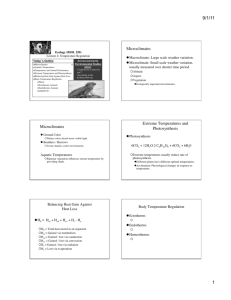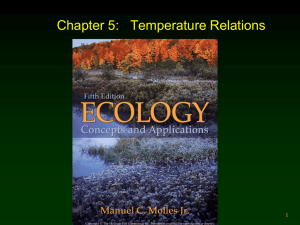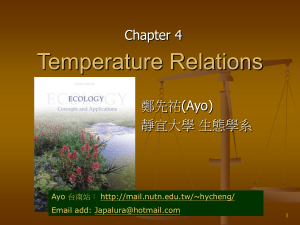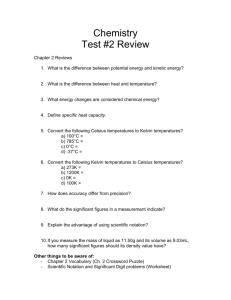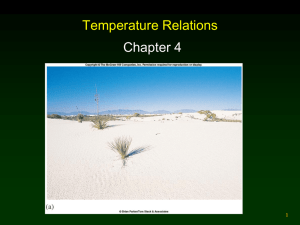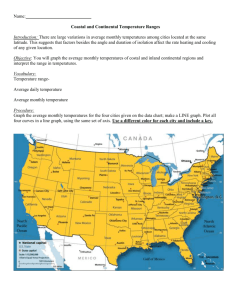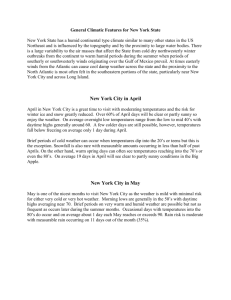**********'}******#}******.}**/}**0}**1}**2}**3}**4}**5}**6}**7}**8}**9
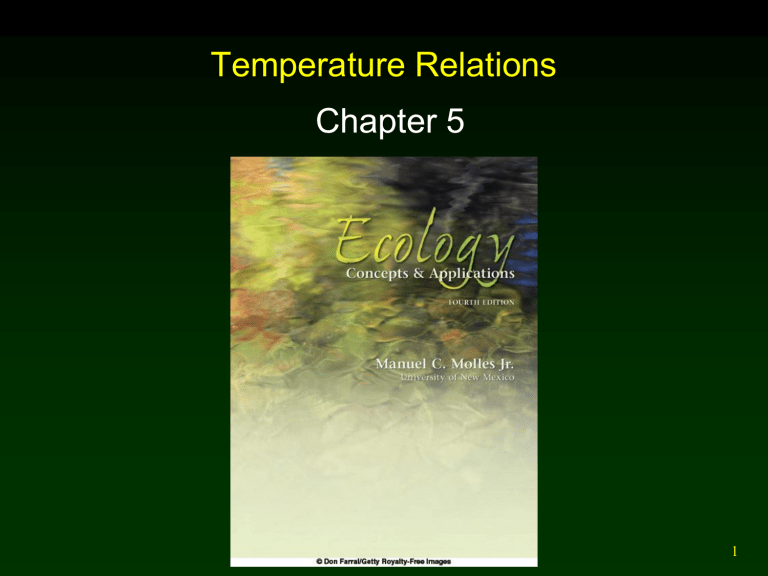
Temperature Relations
Chapter 5
1
Co 5
2
Outline
•
•
•
•
•
•
•
•
Microclimates
Aquatic Temperatures
Temperature and Animal Performance
Extreme Temperature and Photosynthesis
Temperature and Microbial Activity
Balancing Heat Gain Against Heat Loss
Body Temperature Regulation
Plants
Ectothermic Animals
Endothermic Animals
Surviving Extreme Temperatures
3
Figure 05_01
4
Microclimates
•
•
Macroclimate ( 大氣候 ) : Large scale weather variation.
Microclimate ( 微氣候 ) : climatic variation on a scale of few kilometers, meters, or even centimeters, usually measured over short periods of time.
Altitude
Higher altitude - lower temperature.
Aspect
Offers contrasting environments.
Vegetation
Ecologically important microclimates.
5
6
Microclimates
•
•
Ground Color
Darker colors absorb more visible light.
Boulders / Burrows
Create shaded, cooler environments.
7
8
9
10
Figure 05_06
11
Aquatic Temperatures
•
•
•
•
Specific Heat
Absorbs heat without changing temperature.
1 cal energy to heat 1 cm 3 of water 1 o C.
Air - .0003 cal
Latent Heat of Evaporation
About 584 cal per gram of water at 22 o C and 580 cal per gram of water at 35 o C.
Latent Heat of Fusion
1 g of water gives off 80 cal as it freezes.
Riparian Areas
12
Aquatic Temperatures
•
Riparian vegetation influences stream temperature by providing shade.
13
14
5.2 Evolutionary Trade-offs
•
Organisms allocate limited energy to a certain function which then reduces the amount for other functions.
This trade-off ( 交換 ) in energy allocation
( 配置 ) will differ among environments with functions that include growth, reproduction, and defense against predators
15
The Principle of Allocation
•
•
Levins concluded that the evolutionary consequences of this trade-off results in populations having high fitness ( 適當 ) in one environment, but lowered fitness in another environment.
Bennett and Lenski found support for Levins’
Principle of Allocation using experiments with Escherichia coli grown in different temperature environments.
16
The Principle of Allocation
17
Temperature and Animal Performance
•
Biomolecular Level
Most enzymes have rigid, predictable shape at low temperatures
Low temperatures cause low reaction rates, while excessively high temperatures destroy the shape.
Baldwin and Hochachka studied the influence of temperature on performance of acetylcholinesterase in rainbow trout ( Oncorhynchus mykiss ).
18
19
20
21
Figure 05_10
22
Extreme Temperatures and Photosynthesis
•
Photosynthesis
6CO
2
+ 12H
2
O C
6
H
12
O
6
+ 6CO
2
+ 6H
2
0
Extreme temperatures usually reduce rate of photosynthesis.
Different plants have different optimal temperatures.
Acclim a tion ( 馴化 ): Physiol o gical changes in response to temperature.
23
Figure 05_11
24
Optimal Photosynthetic Temperatures
25
Temperature and Microbial Activity
•
•
Morita studied the effect of temperature on population growth among psychrophilic ( 嗜冷
性的 ) marine bacteria around Antarctica.
Grew fastest at 4 o C.
Some growth recorded in temperatures as cold as 5.5
o C.
Some thermophilic (嗜熱性的) microbes have been found to grow best in temperatures as hot as 110 o C.
26
Optimal Growth Temperatures
27
Optimal Growth Temperatures
Antarctic bacteria
28
Optimal Growth Temperatures
Hot spring microbes
29
Balancing Heat Gain Against Heat Loss
•
H
S
= H m
H cd
H cv
H r
- H e
H
S
= Total heat stored in an organism
H m
= Gained via metabolism
H cd
= Gained / lost via conduction
H cv
= Gained / lost via convection
H r
= Gained / lost via electromag. radiation
H e
= Lost via evaporation
30
Heat Exchange Pathways
31
Body Temperature Regulation
•
•
•
Poikilotherms ( 變溫動物 )
Body temperature varies directly with environmental temperature.
Ectotherms ( 外溫動物 )
Rely mainly on external energy sources.
Endotherms ( 內溫動物 )
Rely heavily on metabolic energy.
Homeotherms ( 恒溫動物 ) maintain a relatively constant internal environment.
32
Temperature Regulation by Plants
•
Desert Plants: Must reduce heat storage.
H s
= H cd
H cv
H r
To avoid heating, plants have (3) options:
Decrease heating via conduction (H cd
).
Increase conductive cooling (H cv
).
Reduce radiative heating (H r
).
Leaves with a dense coating of white plant hairs.
33
Temperature Regulation by Plants
34
北極與高山植物的平鋪生長植物
35
Temperature Regulation by Plants
•
•
Arctic and Alpine Plants
Two main options to stay warm:
Increase r a diative heating (H r
).
Decrease Convective Cooling (H cv
).
Tropic Alpine Plants
Ros e tte plants generally retain dead leaves, which insulate and protect the stem from freezing. (蓮座型植物)
Thick pub e scence increases leaf temperature. (軟毛)
36
37
38
A cushion plant
39
柳樹
40
Temperature Regulation by Ectothermic Animals
•
•
Eastern Fence Lizard ( Sceloporus undulatus )
東方強稜蜥
Metabolizable energy intake maximized at
33ºC
Preferred temperature closely matches the temperature at which metabolizable energy intake is maximized
Grasshoppers ( 透翅蝗 )
Some species can adjust for radiative heating by varying intensity of pigmentation during development.
41
Figure 05_20
42
撫養
43
44
高溫抑制食蟲菌
45
46
Temperature Regulation by Endothermic Animals
•
Thermal neutral zone (熱中性區) is the range of environmental temperatures over which the metabolic rate of a homeothermic animal does not change.
Breadth varies among endothermic species.
47
Thermal Neutral Zones
樹懶
幼仔
松鼠
絨猴
48
Temperature Regulation by Endothermic Animals
•
Swimming Muscles of Large Marine Fish
Lateral swimming muscles of many fish
(Mackerel Sharks 灰鯖鯊 , Tuna 鮪魚 ) are well supplied with blood vessels that function as countercurrent heatexchangers.
Keep body temperature above that of surrounding water.
49
Countercurrent Heat Exchange
50
Countercurrent Heat Exchange
藍鰭鮪魚
皮膚的
51
52
Temperature Regulation by Endothermic Animals
•
Warming Insect Flight Muscles
Bumblebees ( 雄蜂 ) maintain temperature of thorax ( 胸甲 ) between 30 o and 37 o C regardless of air temperature.
Sphinx moths 天蛾科 ( Manduca sexta ) increase thoracic temperature due to flight activity.
Thermoregulates by transferring heat from the thorax to the abdomen
53
Moth Circulation and Thermoregulation
54
Temperature Regulation by Thermogenic Plants
•
Almost all plants are poikilothermic ( 變溫的 ) ectotherms ( 外溫生物 ). Plants in family
Araceae use metabolic energy to heat flowers ( 天南星科 ).
Skunk Cabbage ( Symplocarpus foetidus
臭菘 ) stores large quantities of starch in large root, and then translocate it to the inflor e scence (花序) where it is metabolized thus generating heat.
55
Eastern Skunk Cabbage (臭菘)
肉
穗
花
序
主根
56
57
虎甲蟲
58
棲息
59
Surviving Extreme Temperatures
•
•
Inactivity
Seek shelter during extreme periods.
Reducing Metabolic Rate
Hummingbirds enter a state of torpor ( 蟄
伏 ) when food is scarce and night temps are extreme.
Hibernation ( 冬眠 ) - Winter
Estivation ( 夏眠 ) - Summer
60
61
62
